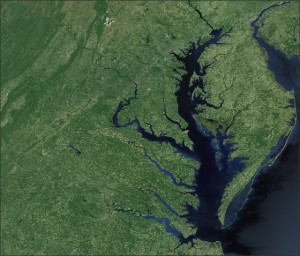Water Quality
...now browsing by category
Wednesday, October 27th, 2010
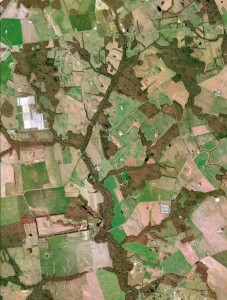
Well-developed riparian forests outline streams and help protect stream water quality.
Most of the time, nutrients are viewed as a positive and essential part of life. However, excess amounts of a nutrient, like nitrogen, can create major ecological problems for the Chesapeake Bay and other aquatic ecosystems. Too much nitrogen leads to an abundance of microscopic plant growth in the water. When the algae die and decay, they consume the oxygen that other organisms need to thrive.
Much of the Bay’s nitrogen pollution comes from farms where rainwater carries nitrate, a form of nitrogen, from fields into streams that drain into the Bay. For years, ecologists have noted that forests and wetlands growing between croplands and streams can reduce the amount of nitrate that reaches the waterways. Scientists have measured nitrate removal by these “riparian buffers,” but only in small study areas.
Click to continue »
Posted in Land Use, Publications, Water Quality | Comments Off on Smithsonian Study Measures Watershed-wide Effects of Riparian Buffers on Nutrient Pollution
Tags: agriculture, Chesapeake Bay, fertilizer, nutrient pollution, riparian buffers, stormwater runoff
Thursday, September 2nd, 2010
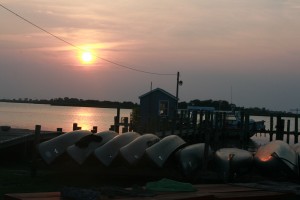
Sunset on canoes in Tylerton, MD
This summer from August 7th through August 13th, 9 students went on a journey through the Chesapeake Bay watershed. This trip was organized and led by Josh Falk, an Education Specialist at SERC, and Kevin Schabow, an educator at the NOAA Chesapeake Bay Office. The purpose of this trip was to immerse high school age students in the complex nature of the science, culture and natural resources that the Bay’s watershed has to offer. This year, the students were assigned to report on what they learned and what they did. Here is their story.
Click to continue »
Posted in Classes and Events, Ecology, Education, Programs, Water Quality | 1 Response »
Tags: Chesapeake Bay, Classes and Events, Programs, Science Education, Watershed
Monday, August 9th, 2010
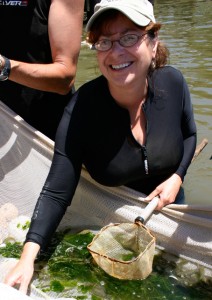
SERC senior scientist Denise Breitburg will lead the NOAA-funded study of hypoxia and acidification in the Chesapeake Bay.
Marine ecologist Denise Breitburg and her colleagues have thought up many novel ways to investigate the impacts of dead zones and acidification on Chesapeake Bay fish and invertebrates. Among their ideas: attaching tiny transmitters to fish and monitoring their movement in relation to oxygen and pH levels. A new $1.4 million grant from the National Oceanic and Atmospheric Administration will enable them to pursue this experiment and a host of others.
Click to continue »
Posted in Ecology, Fisheries, Grants, Water Quality | 2 Responses »
Tags: acidification, hypoxia, oysters
Monday, July 26th, 2010
Hallmark may not have a card for it, but today is International Mangrove Action Day.
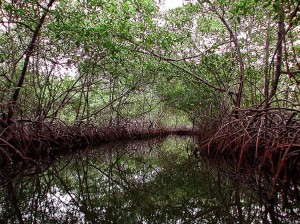
Photo: Ilka C. Feller/Smithsonian Institution
The occasion is a small but vibrant tradition that has been observed annually on July 26th for nearly a decade in countries around the globe, including the U.S., India, Ecuador, Micronesia and many others. To celebrate, some communities organize protests or restoration projects. Some convene discussions or offer educational lectures about mangrove ecology. Others simply take a moment to appreciate the importance of mangrove forests.
Click to continue »
Posted in Ecology, Interviews, Land Use, Water Quality | 4 Responses »
Tags: mangroves
Wednesday, July 14th, 2010
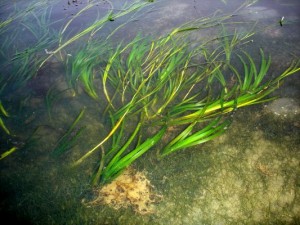
Around the world seagrasses are being lost. Turbidity is one factor that impedes their growth. However, in some places water quality has improved, but the grasses have not rebounded. SERC scientists wonder if a 'carpet of fluff'—a mix of organic and inorganic particles that floats just above the sediment—is blocking the sunlight seedlings need to grow. Photo: Tim Carruthers courtesy of IAN/UMCES.
Peculiar phenomena have always brought researchers together. For SERC senior scientist
Chuck Gallegos and Danish PhD student Troels Møller Pedersen it was a mutual interest in the “carpet of fluff” that floats just above the sediment in estuaries like the Chesapeake Bay. The fluff is a soupy mix of organic and inorganic particles. These particles pose a problem to underwater vegetation because they cloud-out sunlight that the plants, particularly seedlings, need. No one has documented just how much light this layer blocks. Pedersen and Gallegos hope to change this.
Click to continue »
Posted in Ecology, Water Quality | 1 Response »
Tags: Chesapeake Bay, seagrasses, submerged aquatic vegetation, turbidity
Wednesday, May 19th, 2010

Volunteers Richard Hohn and Carla Downes mug for the camera and show off their crab crowns. Photo: Karen McDonald
Face-painted kids and smiling parents fanned out across the Smithsonian Environmental Research Center this past Saturday for the annual open house. They learned about horseshoe crabs, underwater research robots, toe-biting bugs and the rich history of the land. The official count is not yet in, but ask SERC’s outreach coordinator Karen McDonald if she was happy with the turnout and the answer is: yes. Ask her if she’s still recovering from organizing the day’s activities and the answer is also yes.
Thank you to our volunteers, partner organizations, board members and staff for making the day a success. A special thanks to The Chaney Foundation for sponsoring the event and to Peter G. Cane for photographing the day.
Mark your calendars for next year’s open house: Saturday, May 14, 2011.
Posted in Classes and Events, Ecology, Programs, SERC Sites and Scenes, Water Quality | Comments Off on Close encounters with science: SERC’s annual open house
Tags: Open House, slideshow
Tuesday, December 22nd, 2009
Dennis Whigham and Candy Feller both noticed the mangroves’ odd shape. “They almost looked like bonsais,” said Whigham. The shrubs had mature trunks, but the shoots were all new. Feller and Whigham are ecologists at the Smithsonian Environmental Research Center (SERC). To their trained eyes, these trees looked like they were recovering from something like a hurricane. These mangroves survived a different kind of storm: camel grazing.
Saudi Arabia conjures images of the desert, but along the Red Sea coast there are pockets of green dominated by mangroves. Feller and Whigham hunted around for these mangroves during a November visit to the country. They are part of a team of ecologists that’s partnering with the staff of the new King Abdullah University of Science and Technology (KAUST). The school is located on the Red Sea in city of Thuwal.
Click to continue »
Posted in Water Quality | 5 Responses »
Tags: mangroves, Saudi Arabia
Thursday, December 3rd, 2009
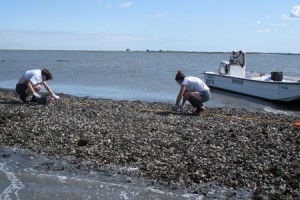
Smithsonian researchers Lori Davias and Jenna Malek collect oysters on an intertidal reef in the Chesapeake Bay. It is difficult to predict the effect of climate change on oyster populations because increasing temperatures will likely have at least two opposing effects. On one hand, intertidal oyster populations may be able to expand northward as winter temperatures rise. On the other hand, increasing summer temperatures are likely to worsen the problem of low oxygen concentrations and may reduce the extent or suitability of some subtidal habitat currently used by oysters. At this point, scientists are unable to predict whether the combination of these two factors will result in a net increase or net loss of habitat. Photo: Sean Fate
It is one of the largest and most productive estuaries in the world, yet dramatic changes are in store for the Chesapeake Bay in coming decades if climate change predictions hold true, say a team of scientists from the Smithsonian Environmental Research Center, the University of Maryland, Pennsylvania State University, and other research organizations in a recent paper published in the journal “Estuarine, Coastal and Shelf Science”
Using forecasts of atmospheric carbon dioxide production for the coming century, the scientists predict the water of the Bay will see rising levels of dissolved carbon dioxide and higher water temperatures. As a result, climate change is expected to worsen problems of low dissolved oxygen concentrations in the Chesapeake’s water and cause sea levels to rise.
Click to continue »
Posted in Climate Change, Fisheries, Publications, Water Quality | Comments Off on Climate change may drastically alter Chesapeake Bay, scientists say
Tags: Chesapeake Bay
Tuesday, November 17th, 2009
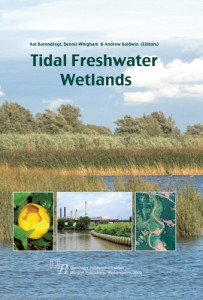
Tidal Freshwater Wetlands
There are certain obstacles you have to embrace if you are going to edit a book about tidal freshwater wetlands. They include: mud, mosquitoes and leeches. Smithsonian plant ecologist
Dennis Whigham has accepted all three and then some.
Whigham, along with colleagues Aat Barendregt from Utrecht University and Andy Baldwin from the University of Maryland, has edited the new book Tidal Freshwater Wetlands. It’s a weighty work containing more than 20 chapters written by more than 40 authors. For the first time ever, they have systematically peeled back the layers of these overlooked coastal ecosystems. The book explores how these wetlands work, the animal and plant life they support, and the threats they face.
Click to continue »
Posted in Climate Change, Land Use, Publications, Water Quality | 2 Responses »
Tags: books, Chesapeake Bay, wetlands










